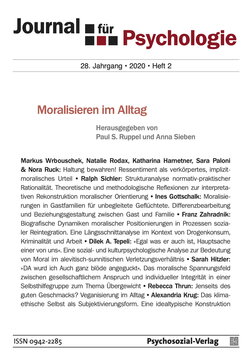22 Seiten, PDF-E-Book
Erschienen: Dezember 2020
Bestell-Nr.: 34054
https://doi.org/10.30820/0942-2285-2020-2-34
abonnieren
Ralph Sichler
Strukturanalyse normativ-praktischer Rationalität (PDF)
Sofortdownload
Dies ist ein E-Book. Unsere E-Books sind mit einem personalisierten Wasserzeichen versehen,
jedoch frei von weiteren technischen Schutzmaßnahmen (»DRM«).
Erfahren Sie hier mehr zu den Datei-Formaten.
Im Beitrag wird auf der Grundlage der Theorie struktureller praktischer Rationalität ein methodologischer Vorschlag zur interpretativen Rekonstruktion der moralischen Dimension menschlicher Handlungen, Überzeugungen und emotionaler Einstellungen zur Diskussion gestellt. Zunächst wird für die Ausgangsthese einer prinzipiellen normativen Imprägnierung menschlicher Handlungsund Lebensformen argumentiert. Im Anschluss daran werden weitere charakteristische Merkmale der Theorie struktureller Rationalität vorgestellt: der rational rekonstruierbare Bezug menschlichen Handelns, Denkens und Fühlens zu (guten) Gründen sowie das strukturelle Moment und die lebensweltlich verfasste Tiefendimension in der Begründung menschlicher Handlungsund Lebensformen. Den Abschluss des Beitrags bilden methodologische Überlegungen zu Optionen und Auswirkungen für die interpretative Sozialforschung.
Abstract:
Based on the theory of structural practical rationality, a methodological essay concerning the interpretative reconstruction of the moral dimension of human actions, beliefs and emotional attitudes is put up for discussion. First, as initial thesis, it is argued for a fundamental normative impregnation of human actions and conduct of life. Afterwards, further characteristics of the theory of structural rationality are presented: the rational relation of human action, thinking and feeling to (good) reasons as well as the structural texture of reasoning. Further the depth dimension of lifeworld is explicated. It can also be used for the the justification of human action and life conduct. The article concludes with methodological considerations on options and implications for interpretative social research.
Abstract:
Based on the theory of structural practical rationality, a methodological essay concerning the interpretative reconstruction of the moral dimension of human actions, beliefs and emotional attitudes is put up for discussion. First, as initial thesis, it is argued for a fundamental normative impregnation of human actions and conduct of life. Afterwards, further characteristics of the theory of structural rationality are presented: the rational relation of human action, thinking and feeling to (good) reasons as well as the structural texture of reasoning. Further the depth dimension of lifeworld is explicated. It can also be used for the the justification of human action and life conduct. The article concludes with methodological considerations on options and implications for interpretative social research.
Paul S. Ruppel & Anna Sieben S. 3–11Editorial (PDF)
Markus Wrbouschek, Natalie Rodax, Katharina Hametner, Sara Paloni & Nora Ruck S. 12–33Haltung bewahren! (PDF)
Ralph SichlerS. 34–55Strukturanalyse normativ-praktischer Rationalität (PDF)
Ines GottschalkS. 56–77Moralisierungen in Gastfamilien für unbegleitete Geflüchtete (PDF)
Franz ZahradnikS. 78–100Biografische Dynamiken moralischer Positionierungen in Prozessen sozialer Reintegration (PDF)
Dilek A. TepeliS. 101–123»Egal was er auch ist, Hauptsache einer von uns« (PDF)
Sarah HitzlerS. 124–146»DA wurd ich Auch ganz blöde angeguckt« (PDF)
Rebecca ThrunS. 147–170Jenseits des guten Geschmacks? (PDF)
Alexandria KrugS. 171–190Das klimaethische Selbst als Subjektivierungsform (PDF)
Markus Wrbouschek, Natalie Rodax, Katharina Hametner, Sara Paloni & Nora Ruck S. 12–33Haltung bewahren! (PDF)
Ralph SichlerS. 34–55Strukturanalyse normativ-praktischer Rationalität (PDF)
Ines GottschalkS. 56–77Moralisierungen in Gastfamilien für unbegleitete Geflüchtete (PDF)
Franz ZahradnikS. 78–100Biografische Dynamiken moralischer Positionierungen in Prozessen sozialer Reintegration (PDF)
Dilek A. TepeliS. 101–123»Egal was er auch ist, Hauptsache einer von uns« (PDF)
Sarah HitzlerS. 124–146»DA wurd ich Auch ganz blöde angeguckt« (PDF)
Rebecca ThrunS. 147–170Jenseits des guten Geschmacks? (PDF)
Alexandria KrugS. 171–190Das klimaethische Selbst als Subjektivierungsform (PDF)

